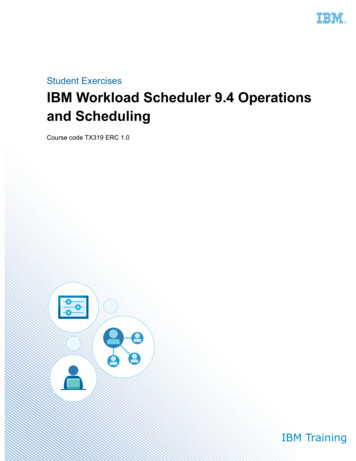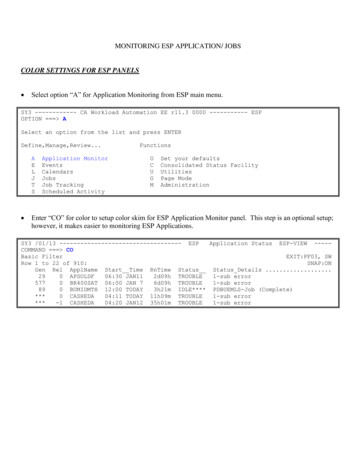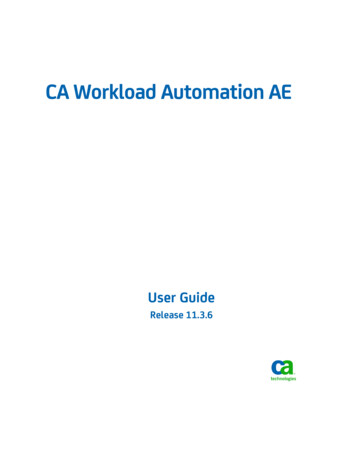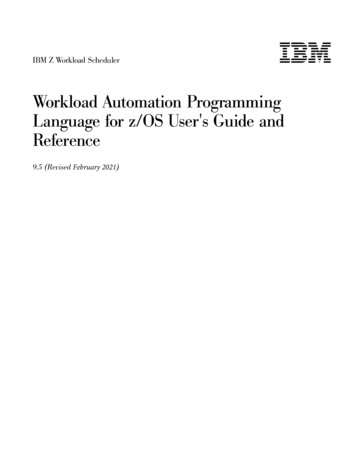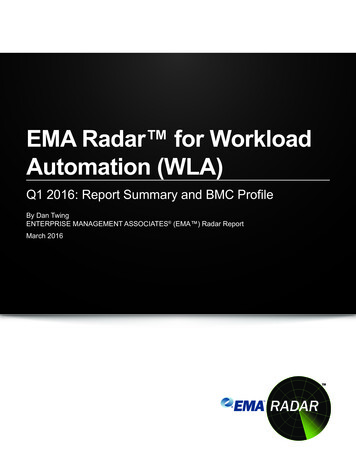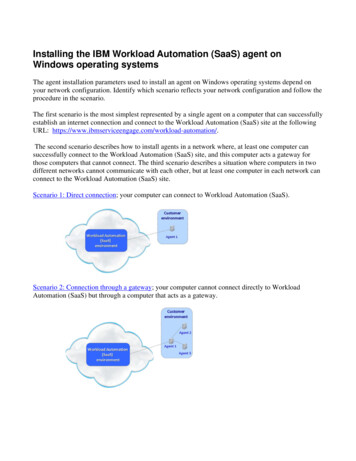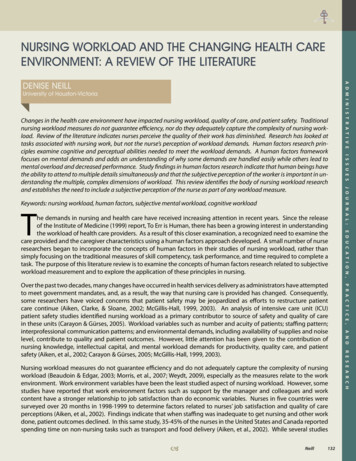
Transcription
NURSING WORKLOAD AND THE CHANGING HEALTH CAREENVIRONMENT: A REVIEW OF THE LITERATUREUniversity of Houston-VictoriaNeill132R E S E A R C HaA N DNursing workload measures do not guarantee efficiency and do not adequately capture the complexity of nursingworkload (Beaudoin & Edgar, 2003; Morris, et al., 2007; Weydt, 2009), especially as the measures relate to the workenvironment. Work environment variables have been the least studied aspect of nursing workload. However, somestudies have reported that work environment factors such as support by the manager and colleagues and workcontent have a stronger relationship to job satisfaction than do economic variables. Nurses in five countries weresurveyed over 20 months in 1998-1999 to determine factors related to nurses’ job satisfaction and quality of careperceptions (Aiken, et al., 2002). Findings indicate that when staffing was inadequate to get nursing and other workdone, patient outcomes declined. In this same study, 35-45% of the nurses in the United States and Canada reportedspending time on non-nursing tasks such as transport and food delivery (Aiken, et al., 2002). While several studiesP R A C T I C E ,Over the past two decades, many changes have occurred in health services delivery as administrators have attemptedto meet government mandates, and, as a result, the way that nursing care is provided has changed. Consequently,some researchers have voiced concerns that patient safety may be jeopardized as efforts to restructure patientcare continue (Aiken, Clarke, & Sloane, 2002; McGillis-Hall, 1999, 2003). An analysis of intensive care unit (ICU)patient safety studies identified nursing workload as a primary contributor to source of safety and quality of carein these units (Carayon & Gürses, 2005). Workload variables such as number and acuity of patients; staffing pattern;interprofessional communication patterns; and environmental demands, including availability of supplies and noiselevel, contribute to quality and patient outcomes. However, little attention has been given to the contribution ofnursing knowledge, intellectual capital, and mental workload demands for productivity, quality care, and patientsafety (Aiken, et al., 2002; Carayon & Gürses, 2005; McGillis-Hall, 1999, 2003).E d U C A T I O N ,The demands in nursing and health care have received increasing attention in recent years. Since the releaseof the Institute of Medicine (1999) report, To Err is Human, there has been a growing interest in understandingthe workload of health care providers. As a result of this closer examination, a recognized need to examine thecare provided and the caregiver characteristics using a human factors approach developed. A small number of nurseresearchers began to incorporate the concepts of human factors in their studies of nursing workload, rather thansimply focusing on the traditional measures of skill competency, task performance, and time required to complete atask. The purpose of this literature review is to examine the concepts of human factors research related to subjectiveworkload measurement and to explore the application of these principles in nursing.J O U R N A L :Keywords: nursing workload, human factors, subjective mental workload, cognitive workloadI S S U E SChanges in the health care environment have impacted nursing workload, quality of care, and patient safety. Traditionalnursing workload measures do not guarantee efficiency, nor do they adequately capture the complexity of nursing workload. Review of the literature indicates nurses perceive the quality of their work has diminished. Research has looked attasks associated with nursing work, but not the nurse’s perception of workload demands. Human factors research principles examine cognitive and perceptual abilities needed to meet the workload demands. A human factors frameworkfocuses on mental demands and adds an understanding of why some demands are handled easily while others lead tomental overload and decreased performance. Study findings in human factors research indicate that human beings havethe ability to attend to multiple details simultaneously and that the subjective perception of the worker is important in understanding the multiple, complex dimensions of workload. This review identifies the body of nursing workload researchand establishes the need to include a subjective perception of the nurse as part of any workload measure.A D M I N I S T R A T I V EDENISE NEILL
VOLUME 1, ISSUE 2A D M I N I S T R A T I V EI S S U E SJ O U R N A L :E d U C A T I O N ,P R A C T I C E ,A N DR E S E A R C Hwere located that have explored the multiple nursing tasks required in the delivery of patient care (Clini, Vitacca, &Ambrosino, 1999; Reis-Miranda, de Rijk, & Schaufeli, 1996; Reis-Miranda, Moreno, & Iapichino, 1997; Weydt, 2009;Yamase, 2003), no studies were found that examined the perception of the “staff nurse” about everyday mentalworkload demands.Beaudoin & Edgar (2003) reported that nurses consistently recount that the quality of their work lives and workenvironment have deteriorated as a result of work content and work environment variables. Thirty to forty percentof the nurses surveyed reported a perceived decrease in quality of care over the past year as a result of the increasingworkload environment demands (Aiken, Clarke, Sloane, & Sochalski, 2001). These perceptions were validated bycomparing nurses’ assessments of quality of care with independent data sources and actual patient outcomes. Thefindings indicated that nurses “do accurately perceive the quality of care, and appear to be able to separate their owncomplaints from those that impact negatively on patients” (Aiken, et al., 2001, p. 260).A study by the American Nurses Association (2001) reported that 75% (n 7,353) of the respondents believed that thequality of nursing care in their work settings had declined over the previous two years. Ninety-two percent of theserespondents related this decline in quality to inadequate staffing. Similar results were found in a study of medicalsurgical nurses in Pennsylvania. Forty-seven percent (n 2,969) stated that the quality of care in their hospitals haddeteriorated over the past year (Aiken, et al., 2002).HUMAN FACTORS RESEARCH BACKGROUNDSince the late 19th century, considerable effort has been expended in the fields of cognitive psychology and humanfactors research to separate workload into physical and mental components and to develop objective measuresof the concept researchers described as mental workload (Kerr, 1973; Moray, 1969; Owen, 1991; Robinson, 1921;Welch, 1898). Mental workload can be defined as the amount of thinking, level of cognitive demand, or thoughtprocessing effort required by the worker to meet the physical, temporal, and environmental demands of the definedtask. Human factors researchers have been interested in mental processing in an attempt to understand the humaninformation processing system and why some demands are handled easily and others lead to signs of mental overloadwith associated decreases in performance. Research in human factors has attempted to address the multiple andcomplex dimensions of the mental workload concept from the subjective perception of the worker. Research studieson mental workload related to information processing and attention indicate that human beings have the abilityto attend to multiple details simultaneously (Braarud, 2001; Georgia Tech., 2011; Haga, Shinoda, & Kokubun, 2002;Huddleston, & Wilson, 1971; Kahneman, 1973; Luximon & Goonetilleke, 2001; Navon, 1985; Owen, 1990, 1991, 1992b;Owen & Haugtvedt, 1993).MENTAL WORKLOAD MEASURESAs work demands become more complex, the need for measures to determine mental workload increases. Severaltechniques have been proposed to quantify the ability to focus on multiple complex phenomena at the same time.Mental workload techniques can be grouped into three broad measures: psychophysical, performance, and subjective(Owen, 1992a; Veltman, 2002). Each measure has specific applications and limitations in determining the mentalworkload associated with the work demands and environment. Table 1 provides an overview of the three workloadmeasures, highlighting the underlying assumption, measurement indicators, and measurement limitations of each.Researchers in the aeronautics, engineering, and health care industries have emphasized the psychophysiologic andperformance demands of workload with much less focus on the subjective perception of the individual performing thework. As the field of human factors research has developed within healthcare, there has been a growing recognitionthat personal perspective about work demands could provide valuable information that impacts quality care andpatient safety. Psychophysiologic and performance measures of workload are traditionally accepted and used, whilesubjective measures have been used in only one identified study (Gregg, 1993). This review will focus on the currentstate of human factors research and establish the need for more nursing workload research utilizing a human factorsframework.133Neillb
A D M I N I S T R A T I V EI S S U E SJ O U R N A L :E d U C A T I O N ,P R A C T I C E ,A N DSubjective mental workload is the amount of work the worker perceives is needed to meet a demand. Theperceived workload is influenced by numerous factors pertaining to the worker, the environment, and the task.There is a presumption, based on subjective experience and the frequent inability of humans to perform two taskssimultaneously, that humans possess a limited capacity central processing system, (Kerr, 1973). Humans must oftenchoose where to focus their attention when faced with competing options. Attention in the context of mentalworkload is the process of selecting from a variety of stimuli for information processing (Navon, 1985). Selection,motivation, and task interference determine the level of attention given to stimuli. Selection refers to the consciouschoice to focus on selected information or a stimulus and is influenced by motivation, which is the person’s desire toaNeill134R E S E A R C HCONCEPTUALIZATION OF SUBJECTIVE MENTAL WORKLOAD
VOLUME 1, ISSUE 2The six distinct categories for attention theories and information processing identified in the literature are summarizedin Table 2. Each theory sought to explain why some people perform a task more efficiently and with greater easethan other people do. The theories assumed a limit to the amount of cognitive stimuli an individual can process atany given time.A D M I N I S T R A T I V EI S S U E SJ O U R N A L :E d U C A T I O N ,P R A C T I C E ,A N DR E S E A R C Hfocus on or process the stimuli. Task interference is anything that inhibits attention or slows down the informationprocessing (Navon, 1984, 1985; Owen, 1992a). Novel stimuli require greater processing and more mental effort thanstimuli that are more familiar. As the amount of mental effort for a task increases, the ability to perform concurrenttasks decreases.135Neillb
MENTAL WORKLOAD: THEORY AND RESEARCHMEASUREMENT OF SUBJECTIVE MENTAL WORKLOADaNeill136R E S E A R C HThe NASA-TLX, developed in 1988 for use with military pilots, is the most widely accepted subjective measure ofhuman workload and has been utilized in research with adults of all ages and both genders (Tomporowski, 2003). Themeasure is a standardized multidimensional subjective rating scale that provides an overall estimation of workloadassociated with task performance. The NASA-TLX has been used in aeronautics, psychology, computer systems,transportation, and the health professions (Haga, et al., 2002; Young, Zavelina, & Hooper, 2008). Studies have foundthe NASA-TLX to have high validity and user acceptance and to have the smallest variability between subjects (Hart& Staveland, 1988; Tomporowski, 2003; Vitense, Jacko, & Emory, 2003; Young, et al., 2008). Six subscales measure therelative contribution of underlying psychological factors to overall workload: demand, physical demand, temporalA N DDuring the late 1970s and throughout the 1980s, the concept of subjective mental workload became increasinglypopular and was operationalized as the individual’s ability to estimate the mental workload experienced at a giventime (Luximon & Goonetilleke, 2001; Reid & Nygren, 1988). There were two major rating scales for estimating subjectivemental workload: the NASA-Task Load Index (NASA-TLX) and the Subjective Workload Assessment Technique (SWAT).P R A C T I C E ,Time-pressure is an important determinant of the total effort associated with mental work and may be imposedby the explicit instruction to hurry or by the demand characteristics of the task. Severe time pressure “arises in anytask which imposes a significant load on short-term memory, because the subject’s rate of activity must be pacedby the rate of decay of the stored elements” (Kahneman, 1973, p. 26). Investing less than standard effort will causedeterioration in the performance. Consciously increasing personal effort beyond what is usual for an individual is notenough in most cases to eliminate all performance errors (Kahneman, 1973). Understanding concepts that contributeto decreased performance and to errors is critical to improving quality and safety in patient care.E d U C A T I O N ,Many attempts to quantify nursing workload rely on either patient acuity or time-to-task measures (Aiken & Patrician,2000; Gregg, 1993). According to the Cognitive Load Theory, conditions that overload the working memory capacitylead to decreased performance. Similarly, as working memory demands are decreased with practice, performanceimproves (Tomporowski, 2003). To determine mental effort or work, a distinction must be made between themomentary effort that a task demands and the total amount of work associated with its completion.J O U R N A L :Like processing capacity, working memory is another limiting factor in processing stimuli and meeting mentalworkload demands for safe, quality patient care. Working memory and familiarity with demands created by taskrequirements impact the perceived mental workload demands. The complexity of mental workload is enhancedby individual differences that make adequate measurement using a single instrument difficult (Benner, 1984; Haga,Shinoda, & Kokubun, 2002; Huddleston, 1974; Huddleston & Wilson, 1971: Kerr, 1973; Morganstern, Hodgson, & Law,1974; Moray, 1969; Navon, 1984, 1985; Owen, 1990, 1991, 1992a, 1992b; Tomporowski, 2003; Veltman, 2002).I S S U E SMental workload is a complex construct with multiple dimensions. Mental workload perception is determined bythe individual’s processing capacity and the requirements of the task. Processing capacity is influenced by individualcharacteristics (e.g. skill level, energy, personal behaviors and perceptions), performance circumstances (e.g. workenvironment and time demands), activity complexity (e.g. routine activity vs. special or emergency procedure), andindirect influences (e.g. staffing pattern, administrative support, non-direct care requirements).A D M I N I S T R A T I V EThe theories point to limits in the human ability to process information. At times, humans are able to perform parallelactivities (e.g., driving and talking) with varying levels of success. When two stimuli are presented together, the stimuliare addressed sequentially rather than simultaneously, suggesting the presence of a bottleneck in the individual’sprocessing ability (Kahneman, 1973). Limited capacity theories assume that, when there is enough stimulation, thesignals interfere with each other and reduce the efficiency and speed of the signal response (Kerr, 1973). As nurses’demands increase, the limited capacity to handle the incoming stimuli can lead to errors that decrease the qualityand safety of patient care.
VOLUME 1, ISSUE 2demand, performance, effort, and frustration (Hart & Staveland, 1988; Vitense et al., 2003; Young, et al., 2008). Gregg(1993) was the first to measure subjective mental workload in a group of intensive care nurses.A D M I N I S T R A T I V EI S S U E SJ O U R N A L :E d U C A T I O N ,P R A C T I C E ,A N DR E S E A R C HMEASUREMENT OF, AND INFLUENCES ON, NURSING WORKLOADThe lack of a clear definition in the literature has been identified as one of the major problems with understandingand measuring nursing workload (Morris, MacNeely, Scott, Treacy & Hyde, 2007). Additionally, there is a tendencyto use the concepts of nursing work and nursing workload interchangeably. Nursing work describes the functionaltasks such as assessment or medication administration that the nurse carries out to benefit the patient. In contrast,nursing workload is best described as “the amount of performance required to carry out those nursing activities ina specified time period” (Morris, et al., 2007, p. 464). Workload has been identified by ICU nurses as one of the mostimportant job stressors (Aiken et al., 2002; Carayon & Gürses, 2005). High workload levels have been associated withsuboptimal patient care (Carayon & Gürses, 2005). Providers with high workloads also eliminate non-essential caretasks and procedures. Potential adverse outcomes linked to high workload include reduced patient satisfaction, poornurse-patient communication, impaired nurse-physician collaboration, nurse burnout, and job dissatisfaction (Aikenet al., 2002; Carayon & Gürses, 2005).Nursing workload is affected by many different factors, some of which are more stable and easier to measure thanothers (Scott, n.d.). Easily measured variables include the number of admissions, patient census, procedures, turnover,case mix, and average age of the clients. Less easily quantifiable factors with a direct impact on nursing workload atthe point of care include environment, the institution’s philosophy of nursing, the type of staffing (e.g., primary careor team nursing), the individual characteristics of the nursing staff (e.g., education, experience, and skill level), and thepatterns of medical treatment (Hegney, Plank, & Parker, 2003; Page, 2004; Stone, et al., 2003). One of the difficultiesin measuring nursing workload is related to the varying definitions and standards used across systems that makecomparison of data more difficult and research more challenging.Traditional MeasuresWorkload in nursing has typically been measured in terms of the number of patients, the number of care hoursper patient, or by applying a patient acuity system based on medical diagnosis and care activities (Claudio, 2004;Gregg, 1993; Holcomb, Hoffart, & Fox, 2002; Slomka, Fulton, & Fitzpatrick, 2001; Walsh, 2003). Using these measures isfraught with problems. Determining nursing workload by historical acuity or census calculations does not reflect theactual workload of caring for patients on the unit. A key problem is that acuity measures do not account for many ofthe activities involved in actual patient care, such as educating family, coordination of care activities with other healthcare team members to meet patient needs, and unanticipated changes in the patient’s condition (Walsh, 2003).Attempts to measure nursing workload based on the perceptions of the head nurse assumed head nurses wereaware of the patient care and nurse needs and could recognize when staff were overworked (Trivedi & Hancock,1975). Patient load for a shift was determined by examining patient census and considering admissions, discharges,and transfers. Only two variables were found to be significant in determining the head nurse’s perception of theseverity of need for nursing care: nursing hours available on the unit and unit census. Many of the measures usedby nurse administrators to evaluate the nursing work environment, such as employee absenteeism, turnover, andpatient satisfaction, are trailing indicators or markers of workload. Reliance on these trailing indicator measures is areactive rather than proactive approach to dealing with workplace issues (McLennan, 2005).Cognitive or Mental MeasuresBesides using incomplete data, acuity system measurements lack the ability to measure mental demands placedon nurses (Gregg, 1993; Jennings, Rea, Antopol, & Carty, 1989; Yamase, 2003) and situation-level variability (Carayon& Gürses, 2005). Nurses in clinical settings have expressed concern that acuity or patient number-based staffingmeasures do not accurately reflect their workload, because such measures do not take into account the mentaldemands and stresses of workload (Jennings, Rea, Antopol, & Carty, 1989; Meierhoffer, 1991; Schneider, 1994). With137Neillb
NURSE WORKING CONDITIONS AND OUTCOMESP R A C T I C E ,A N DReview of the workload literature identified the common stress of technologically advanced work environments forpilots, air traffic controllers, flight deck operators, transportation industry drivers, and nurses and noted that theNASA-TLX had been used to evaluate the perceptions of workload associated with clinical education in anesthesia(Young, et al., 2008). The NASA-TLX served as the foundation for the Nursing Task Load Index (Nursing TLX) developedto measure ICU nurses’ perceptions of workload (Gregg, 1993).Many measures of workload in nursing are designed based on the needs and condition of the patient, thus evaluatingnursing workload based on patient care activities. Carayon and Gürses (2005) conducted a literature review on nursingworkload studies in intensive care settings and examined the findings for impact on the quality of patient care andNeill138R E S E A R C HNURSING WORKLOAD AND THE HUMAN FACTORS(SUBJECTIVE MEASURE) APPROACHaE d U C A T I O N ,Staffing effectiveness indicators adopted by The Joint Commission Accreditation of Hospitals (JCAH) in July 2002 andpatient outcomes are two commonly used measures to evaluate nursing workload (McLennan, 2005; Smith, 2002;Stone et al., 2003). For JCAH accreditation, agencies are required to choose a minimum of four indicators (two clinical/service and two human resource) from a list of indicators provided, and they are then expected to report the datasummary and analyses related to effectiveness of staffing on patient outcomes to their administration each year. Thisreport also includes suggested actions that may be undertaken to improve outcomes, including alterations to nursestaffing (Stone et al., 2003). These staffing effectiveness measures require that workload measurement go beyondpatient diagnosis and nurse patient ratios to uncover the care hours needed to meet a specific patient population’sneeds (Walsh, 2003). Until the composition of nurse work and factors affecting nurses’ work lives are understood, thequality of nurse work cannot be enhanced (Beaudoin & Edgar, 2003).J O U R N A L :Mandated nurse-patient ratios is a method that has been proposed to improve quality outcomes in hospitals andkeep nursing workload at a manageable level. Some researchers feel that mandating nurse-to-patient ratios alone,without ensuring that other work environment characteristics are considered, is short-sighted (Smith, 2002; Stone etal., 2003). They argue that the stakes are high, not only because of the potential for poor patient outcomes, but alsobecause having nurses who are overworked and overloaded may lead to even greater erosion of quality care.I S S U E SThere is a growing body of literature supporting the conclusion that nurse staffing and workload affect nursesatisfaction (Beaudoin & Edgar, 2003; Smith, 2002), nurse turnover (Allen & Mellor, 2002; Jolma, 1990; Smith, 2002),and patient outcomes (Page, 2004; McLennan, 2005; Morrissey, 2003; Ramanujam, et al., 2008; Smith, 2002). Evidencesupports an inverse relationship between RN staffing levels and the incidence of urinary tract infections, pneumoniaacquired after surgery, and antibiotic resistant organisms in intensive care units (Stone et al., 2003). Other staffingfactors related to patient safety outcomes include a link between fewer years of experience in the clinical unit andpatient mortality, and the development of infection at higher rates for new admissions cared for by agency or “pool”nurses than with permanently assigned intensive care unit staff. High nursing workload has been shown to be relatedto suboptimal patient care and nurse burnout (Aiken et al., 2002). Staffing variables are one aspect of nursing practiceenvironments that may affect outcomes not only for patients, but also for nurses and organizations (Stone et al.,2003).A D M I N I S T R A T I V Etraditional workload measures, nurses may feel they are working too hard or that patient outcomes are unsatisfactory(Page, 2003). Ramanujam, Abrahamson, and Anderson (2008) reported that the nurses’ perception of workloaddemands has an inverse relationship to their perceived ability to provide safe care. As the workload demands increase,the perception that safe care delivery can be achieved diminishes. Additional signs of increases in the workload ofnurses might be seen in declining patient satisfaction scores; increasing numbers of nurses who work overtime; andsigns of stress and burnout in nurses, such as fatigue and dissatisfaction with the job or with nursing as a profession(Walsh, 2003; McLennan, 2005).
A D M I N I S T R A T I V EI S S U E SJ O U R N A L :E d U C A T I O N ,P R A C T I C E ,A N DR E S E A R C HVOLUME 1, ISSUE 2safety and nurses’ quality of working life. They identified both macro and micro level influences on workload. Macrolevel influences are common to all nurses, while micro-level influences are those that are short-term and uniqueto the combination of factors involved at a specific point in time (i.e. patient factors, interdisciplinary interactions,work environment, and personal characteristics of the nurse). Based on this review, Carayon and Gürses proposeda conceptual framework that defined causes, consequences, and outcomes of workload. Using a human factorsengineering approach, they defined four different levels of nursing workload: unit level, job level, patient level, andsituation level.Levels of Nursing WorkloadThe unit level measure was based on measures such as nurse-patient ratio, nursing care hours, and bed occupancy,with some modification based on nurse education and experience levels. These workload measures were describedas macro-level because they did not consider unique features of each ICU (i.e., the contextual and organizationalcharacteristics) (Carayon & Gürses, 2005).Job level workload provided information about ICU nursing compared to other jobs. The overall perceived workloadwas evaluated, and the quality of working life and patient care were considered (Carayon & Gürses, 2005). A variety ofinstruments are available for estimation of nursing workload based on patient care activities, including the simplifiedTherapueutic Intervention Scoring System (TISS) (Reis-Miranda, et al., 1996), Nine Equivalents of Nursing ManpowerUse Score (NEMS) (Reis-Miranda, et al., 1997; Rothen, Küng, Ryser, Zürcher, & Regli, 1999), Revised Nursing Work Index(NWI-R) (Aiken & Patrician, 2000), and Comprehensive Nursing Intervention Score (CNIS) (Yamase, 2003).Since measures that are based on the patient’s condition are not particularly helpful in understanding the impactof situations on nursing workload, Carayon and Gürses (2005) introduced the situation-level workload to explaintemporally bound events in the clinical micro system. The situation-level workload is evaluated for a particular eventor over a short time period, such as a shift. Carayon and Gürses proposed the use of human factors engineeringworkload measures, such as the NASA TLX or SWAT, to assess this situation-level workload. They identified the needto consider both the contextual factors of the environment and patient demands and the individual attributesof nurses when examining nursing workload in the ICU setting. Using human factors engineering knowledge,approaches, and measurement methods to evaluate workload “can provide direction for specific interventions thatcan be implemented in ICUs in order to improve nursing quality of working life and quality and safety of patient care”(Carayon & Gürses, 2005, p. 298).Measurement of Nursing Workload Using a Human Factors ApproachIn the earliest study of subjective mental workload identified in nursing, Gregg (1993) developed the Nursing TaskLoad Index (Nursing TLX) to examine cardiovascular critical care unit nurses’ subjective mental workload in relation tospecialty and general experience and education. The Nursing TLX is based on the NASA Task Load Index and consistsof both scales that measure work demand and scales that measure responses to those demands. The final versionof the Nursing-TLX includes seven scales: mental demand, physical demand, temporal demand, environmentaldemand, effort, performance, and emotionalism. Internal consistency of the total Nursing TLX was reported as α .82, similar to that reported for the NASA-TLX, α .87 (Hart & Staveland, 1988). According to Gregg, the internalconsistency was similar to that reported (α .80 - .83) in a study by Bertram which adapted the NASA-TLX for usewith physicians. Inter-item correlations were highest between Temporal Demand and Effort, r .79, p .0001, andbetween Performance and Emotionalism, r .72, p .0001.Gregg (1993) defined the task for her study as “four hours of patient care” (p. 108). She reported no significantrelationship between specialty experience and subjective mental workload for participants in the study. Greggsuggested that the absence of a significant relationship between specialty experience and subjective mental workloadmay be an indicator that much of the information was processed automatically. She also reported an “essentiallyzero correlation coefficient between general experience and subjective mental workload” (Gregg, p. 106), which shefound puzzling, based on the prior research indicating that more information can be processed by individual
Changes in the health care environment have impacted nursing workload, quality of care, and patient safety. Traditional nursing workload measures do not guarantee efficiency, nor do they adequately capture the complexity of nursing work-load. Review of the literature indicates
